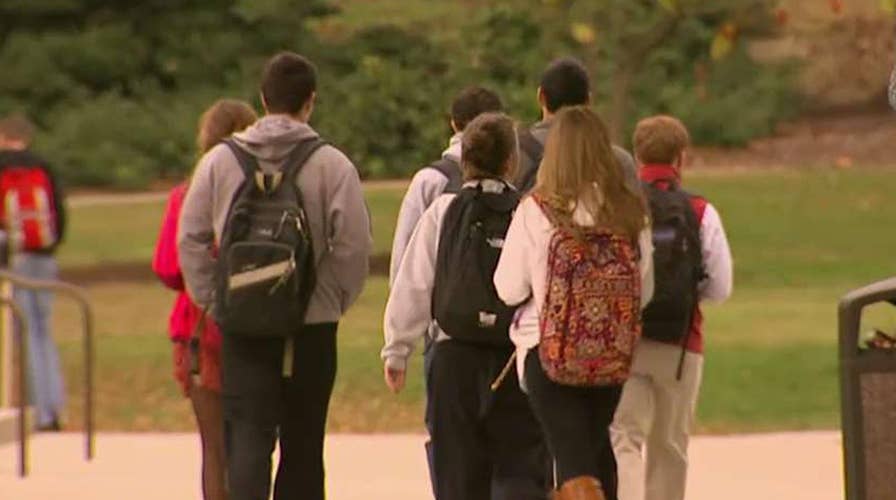Rpt: Missing paperwork could void $5B in student loan debt
Fox Business Network's Gerri Willis explains
The Trump administration inherited a massive student loan mess from the Obama administration, which inherited the seedlings of today’s crisis from the Bush administration. Over a million Americans now default on their student loans each year. And if Education Secretary Betsy DeVos and her team fail to act fast, they will soon become complicit in a government debacle that exceeds the savings and loan bailout of the 1980s in scale.
Today’s saga started just before the Great Recession, when President George W. Bush authorized billions in student aid and signed into law forgiveness initiatives that allowed public service workers to write off any remaining debt after just 10 years of repayment. More recently, the Obama White House expanded Bush-era loan forgiveness and replaced our bank-based student loan program with a government-run “direct lending” program.
The problems with direct lending began almost immediately: repayment rates plummeted, and late last year, the GAO issued a scathing report arguing that oversight of the loan program suffered either from incompetence or malfeasance. Along the way, the U.S. Department of Education miscalculated likely losses from a segment of loans by an estimated $100 billion.
There are over seven million Americans in default on their student loans already. Over 20 million more Americans have little or no hope of ever paying down their loans. Many will suffer irreconcilable damage to their credit scores, impacting their ability to get a mortgage, buy a car or get a job.
Albeit well-intentioned, the Department of Education now sits atop the largest sub-prime lending bubble since the mortgage boom – except this time the predatory lender is the U.S. government.
Since the federal government took over the loan program in 2010, the Department has issued nearly $1 trillion in student loans. The Wall Street Journal’s Josh Mitchell reports that 35 percent of borrowers were sub-prime. Fifteen percent had no credit score at all. As it turns out, federal loans have virtually no underwriting standards – education equivalents of now infamous “liar loans” that fueled the mortgage crisis.
One might imagine that the ballooning federal burden reflects a boon for student borrowers. But in an ironic twist, the statutory interest can now reach almost eight percent - more than double the two to three percent students paid under the bank-based system. As a result, less than 60 percent are now making interest and principal payments while rate hikes fund an estimated $30 billion in Obama-era health care programs.
To add insult to injury, a GAO report released last month now indicates that improper payment rates in the direct lending program could be as high as five percent. It’s no wonder that stories of fraud, poor servicing, and massive losses are starting to surface. The U.S. Department of Education is one of the smallest federal agencies – ill-equipped to manage a trillion-dollar pool of loans. So what should Secretary DeVos do?
First, tell the American people the extent of the problem. Published estimates suggest the current write-down for student loans will exceed $500 billion. No intelligent conversation can be had about the economic risk and opportunities of policies like income-based repayment or public service loan forgiveness until the government writes off enough to give policymakers the flexibility they need to fix the problem.
Second, explore administrative channels to slow the pace of borrowing. Currently, a borrower (or a parent co-signer) can borrow enough money to destroy their financial future with little paperwork, no counselling, and virtually no information on potential negative ramifications. The secretary could implement a seven-day waiting period between applying for a loan and receiving a loan. During such a waiting period, borrowers should receive disclosure schedules written in plain English. Secretary DeVos could offer guidance to encourage aid counselors to recommend less debt and provide more frequent updates on expected payments.
Third, the secretary should embrace the transfer of the loan program to the U.S. Department of the Treasury. The loan program is rife with political risk and the future will focus on garnishing wages and tax refunds to collect unpaid student loan balances. Default rates will continue to soar until the Treasury has the expertise and tools to enforce payment. There is only downside for Secretary DeVos in owning the student loan debacle, and she will find herself deep in the unwinnable morass of student loan politics.
Finally, restricting access to student debt at a time when a college degree is table stakes for economic mobility will, sadly, hit our most vulnerable students hard. Therefore, the secretary should consider efforts to ease the pain for low-income Americans that have little financial impact on the Treasury. For example, it costs more to collect on small loans than the government gains. Secretary DeVos could argue for loan forgiveness for all loans below $3,000 (and in the interim instruct servicers not to engage in legal actions against such borrowers).
The human toll of the student loan crisis is staggering. There are over seven million Americans in default on their student loans already. Over 20 million more Americans have little or no hope of ever paying down their student loans. Many will suffer irreconcilable damage to their credit scores, which will impact their ability to get a mortgage, buy a car or get a job. The government created this mess. Hopefully the administration is in a unique position to tell the truth to the American people about the size of the crisis and put steps in place to fix the issues, rather than make them worse.

